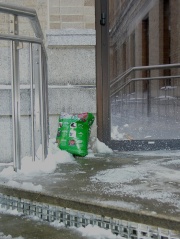Difference between revisions of "Freeze-thaw cycle"
Jump to navigation
Jump to search
| (One intermediate revision by one other user not shown) | |||
| Line 12: | Line 12: | ||
Frost-Tau- Wechsel (Deut.);cycle gel-dégel (Fr.); ciclos de gelo-degelo (Port.) | Frost-Tau- Wechsel (Deut.);cycle gel-dégel (Fr.); ciclos de gelo-degelo (Port.) | ||
| − | == | + | ==Resources and Citations== |
* ''Dictionary of Building Preservation'', Ward Bucher, ed., John Wiley & Sons, Inc., New York City, 1996 | * ''Dictionary of Building Preservation'', Ward Bucher, ed., John Wiley & Sons, Inc., New York City, 1996 | ||
Latest revision as of 14:21, 26 August 2020
Description
A degradative mechanism that occurs when ambient temperatures cycle above and below the freezing point of water. Freeze-thaw cycles cause spalling in masonry and potholes in pavement. At temperatures above the freezing point, liquid water can seep into crevices, pool in cracks, and collect in numerous fine pores of stone, pavement and concrete. When the temperature drops and the water freezes, the pressure of the ice due to its volume expansion splits and disrupt the integrity of the surrounding matrix.
See also Antifreeze and Ice melter.
Synonyms and Related Terms
Frost-Tau- Wechsel (Deut.);cycle gel-dégel (Fr.); ciclos de gelo-degelo (Port.)
Resources and Citations
- Dictionary of Building Preservation, Ward Bucher, ed., John Wiley & Sons, Inc., New York City, 1996
